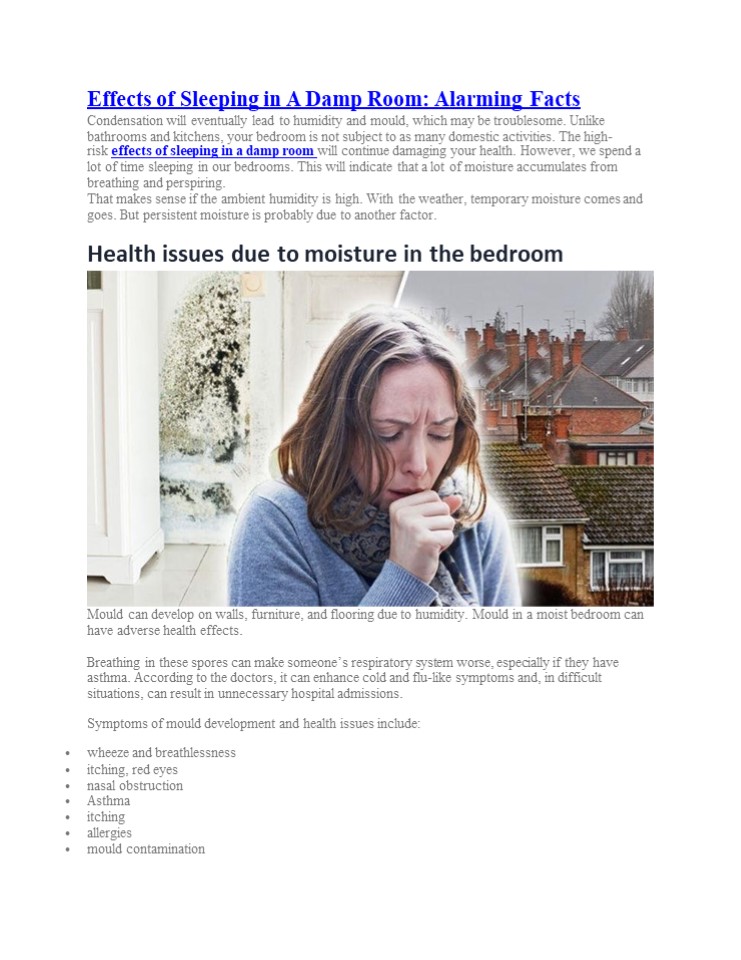Effects of Sleeping in A Damp Room: Alarming Facts - PowerPoint PPT Presentation
Title:
Effects of Sleeping in A Damp Room: Alarming Facts
Description:
Condensation will eventually lead to humidity and mould, which may be troublesome. Unlike bathrooms and kitchens, your bedroom is not subject to as many domestic activities – PowerPoint PPT presentation
Number of Views:1
Title: Effects of Sleeping in A Damp Room: Alarming Facts
1
Effects of Sleeping in A Damp Room Alarming
Facts Condensation will eventually lead to
humidity and mould, which may be troublesome.
Unlike bathrooms and kitchens, your bedroom is
not subject to as many domestic activities. The
high- risk effects of sleeping in a damp room
will continue damaging your health. However, we
spend a lot of time sleeping in our bedrooms.
This will indicate that a lot of moisture
accumulates from breathing and perspiring. That
makes sense if the ambient humidity is high. With
the weather, temporary moisture comes and goes.
But persistent moisture is probably due to
another factor.
Health issues due to moisture in the bedroom
- Mould can develop on walls, furniture, and
flooring due to humidity. Mould in a moist
bedroom can have adverse health effects. - Breathing in these spores can make someones
respiratory system worse, especially if they have
asthma. According to the doctors, it can enhance
cold and flu-like symptoms and, in difficult
situations, can result in unnecessary hospital
admissions. - Symptoms of mould development and health issues
include - wheeze and breathlessness
- itching, red eyes
- nasal obstruction
- Asthma
- itching
- allergies
- mould contamination
2
Causes of moisture in the bedroom
Many things can generate moisture in the bedroom.
Discussed below are a few of the causes Leaky
roof If a roof leak occurs water will seep
through into the ceiling below and over time the
bedroom will become damp. Bathroom dampness The
moisture produced in the bathroom, such as from
hot showers and running water, can cause
bedrooms with an adjoining bathroom to become
damp. But we probably suffer more negative
effects of sleeping in a damp room than taking a
quick shower in a mouldy bathroom. Stale and
sticky air Its possible that trapped air in a
house wont be able to dehumidify or dry out.
Insufficient fresh air, ventilation systems, and
dehumidified air can all contribute to damp
bedrooms. Plumbing problem Plumbing pipes may
leak without our knowledge. Mould in a bedroom
could be coming from leaking central heating
pipes an adjoining bathroom, kitchen, or laundry
room that has plumbing issues, that could be the
source of the dampness. Useless Gutters Gutters
that are too small, fitted improperly, or clogged
with debris cannot function as intended. In each
instance, water leaks past the gutters border
and may gradually seep through an outside wall,
which lets moisture inside the home. Bedrooms
with external walls can then develop moisture
problems.
3
How Can You Get Your Bedroom Dry?
How do you get rid of damp in the bedroom now
that weve discussed the causes? The sort of damp
will determine this. For instance, condensation
can easily be reduced by regularly opening
windows to increase ventilation. Additionally,
if your bathroom is close to your bedroom, we
advise turning on your extractor fan to avoid
the harmful effects of sleeping in a damp room.
This will assist in removing any extra moisture
that may find its way into the bedroom. Finding
the leak or exterior flaw causing your bedrooms
penetrating moisture is of utmost importance. If
you rent your property from your local council or
housing association, you need to contact them as
they are legally bound to rectify your issues. If
you own your own home, contact a professional
tradesman to undertake the work.
A checklist for removing mould-contaminated
objects
4
- Make it a practice to frequently examine
locations like the carpets, behind furniture, and
curtains. - Wipe down the affected area with a mild cleaning
agent to remove the mould. Once the mould has
been removed use a dry cloth to wipe away any
excess moisture. - Mould germs will be released into the air while
cleaning. It is recommended to prevent these - microorganisms from spreading to other parts of
the house open any windows in the room but keep
the room door closed. Both during and after the
cleaning process, leave the windows open. - Clothing and soft toys with a musty smell should
be washed thoroughly. Have musty carpets and
rugs professionally cleaned. A mattress with a
musty scent should be disposed of. - All surfaces in the area should be thoroughly
cleaned once the mould has been removed. Use a - HEPA air purifier to catch any spores that may
have dispersed during the mould removal process. - Conclusion
A roof leak, plumbing leak, moist air,
inefficient guttering, and humidity from an
adjacent bathroom are just a few causes of
dampness in bedrooms. The growth of mould may be
a result of this extra
5
moisture. As a result, the adverse effects of
sleeping in a damp room can cause or exacerbate
health issues like nasal congestion, allergies,
asthma, and mould infections.































